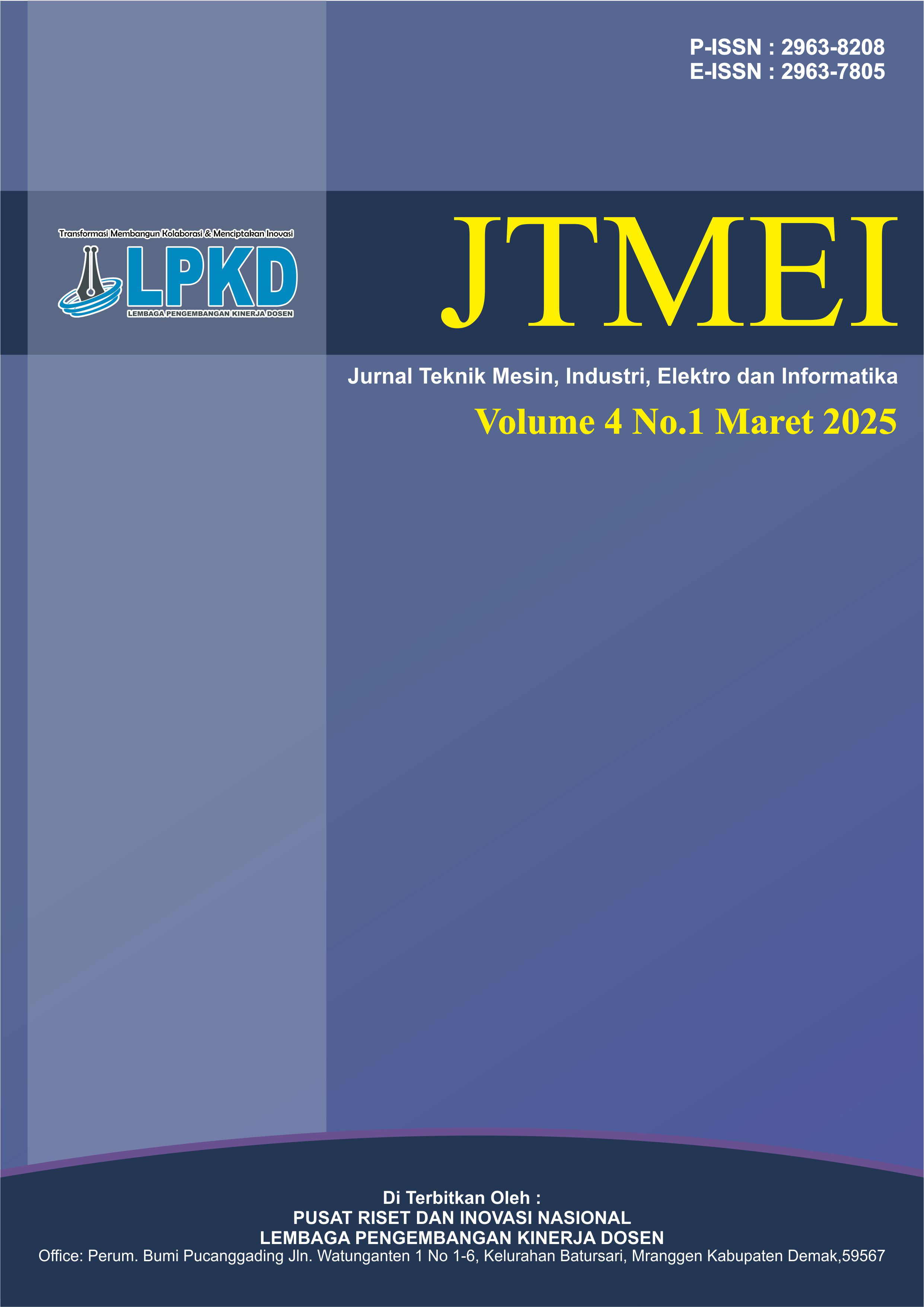Pengaruh Azimuth terhadap Intensitas Cahaya, Tegangan, dan Arus Panel Surya 50 WP Off-Grid pada Program Match Fund Solar Cell UNTIRTA
DOI:
https://doi.org/10.55606/jtmei.v4i1.4761Keywords:
Light Intensity, Electrical Voltage, Electric Current, Azimuth, Solar PanelAbstract
The adverse impact of fossil fuel use on the environment has prompted various parties to look for alternative solutions that are more environmentally friendly. One potential renewable energy source is solar energy. Solar panels, which function to convert solar energy into electrical energy, are the top choice because of their abundant abundance, clean nature, and ability to reduce dependence on fossil fuels. However, the performance of solar panels is affected by several factors, one of which is azimuth. The azimuth angle determines the orientation of the solar panel on the horizontal plane. The proper azimuth orientation helps to improve the overall efficiency of solar energy collection. A non-optimal azimuth angle can reduce the intensity of light received by the panel surface, thereby lowering the electrical voltage and the generated electric current. In off-grid systems, which rely entirely on solar energy to meet electricity needs, proper azimuth arrangement becomes crucial to ensure light absorption efficiency. From the results of the experiment, it was found that the influence of azimuth on light intensity, voltage and current was greater in the North position with a position of 0 degrees where a light intensity of 92000 lux, a voltage of 20.01 V, and a current of 2.0 A were obtained, so it can be concluded that the cardinal direction and angle can affect the intensity of light, electrical voltage and electric current obtained.
Downloads
References
Amani Darma Tarigan, P. W. (2022, Juli). Perancangan Otoped Listrik Menggunakan Panel Surya Sebagai Media Transportasi. RELE (Rekayasa Elektrikal dan Energi) : Jurnal Teknik Elektro, Vol. 5.
Arindya, R. (2021). Pembangkit Listrik Tenaga Surya (PLTS). Kapalo Koto, Sumatera Barat.
Esmeralda Contessa, D. P. (2009). Saluran Udara Tegangan Ekstra Tinggi (SUTET) dan Pengaruhnya Terhadap Kesehatan Lingkungan. Jakarta: Esensi.
Evrita Lusiana Utari, I. M. (2018, Februari). Penyuluhan & Aplikasi Energi Terbarukan (Solar Cell) Guna Memenuhi Kebutuhan Energi Alternatif Pengganti Listrik Di Wilayah Dusun Nglinggo Kelurahan Pagerharjo Kecamatan Samigaluh Kabupaten Kulon Progo. Jurnal Pengabdian “ Dharma Bakti “, Vol.1, No.1.
Gultom, T. T. (2015). PEMANFAATAN PHOTOVOLTAIC SEBAGAI PEMBANGKIT LISTRIK TENAGA SURYA. Jurnal Mudira Indure, 34-35.
Haryudo, A. N. (2020). RANCANG BANGUNPROTOTYPE PEMBANGKIT LISTRIK TENAGA ANGINMENGGUNAKAN TURBIN ANGIN SAVONIUS. Jurnal Teknik Elektro, Volume 09, Nomor 01, 711-717.
Ibnu Hajar, Y. J. (2021). Implementasi Solar Cell Panel untuk penerangan umum di Wilayah Serang Baru -Bekasi. Seminar Nasional Pemberdayaan Masyarakat, Vol. 3, 289-295.
Khwee, K. H. (2013, Oktober). Pengaruh Temperatur Terhadap Kapasitas Daya Panel Surya (Studi Kasus: Pontianak). Jurnal ELKHAA, Vol. 5, No 2, 23.
Muhamad Rusdi, H. d. (2021, Juni 3). Sosialisasi Pemanfaatan Energi Terbarukan Dan Pelatihan Teknologi Tepat Guna Berbasis Solar cell Untuk Pelajar SMPIT Ibnu Sina Merauke. Jurnal Pengabdian Masyarakat Indonesia (JPMI), Vol. 1, 79-84.
Muhammad Sulthan Qintara, S. S. (2020, April). SISTEM PEMANTAUAN DAN KONTROL PARAMETER BATERAI AKI PADA ROBOT EDUTAINMENT BERBASIS ARDUINO & ANDROID. e-Proceeding of Engineering, Vol.7, No.1, 258-264.
Nayak, S. P. (2017). Solar Energy. McGraw-Hill Education.
Ponto, H. (2018). Dasar Teknik Listrik. Yogyakarta: DEEPUBLISH.
Rajabiah, M. B. (2019, Mei). Analisis Kemampuan Panel Surya Monokristalin 150 Watt pada Arus dan Pengisian yang Dihasilkan. JIPFRI (Jurnal Inovasi Pendidikan Fisika dan Riset Ilmiah), Vol. 3 No. 1, 30-31.
Sentagi Sesotya Utami, R. F. (2018). Menelusur Jejak Implementasi Konsep Bangunan Hijau dan Pintar di Kampus Biru. Yogyakarta: Gajah Mada University Press.
Setiyo, M. (2017). Listrik & Elektronika Dasar Otomotif (Basic Automotive Electricity & Electronics). Magelang: UNIMMA PRESS.
Silalahi, W. (2021). Analisis Pengaruh Intensitas Cahaya Matahari dan Suhu Permukaan Panel Surya Terhadap Energi yang Dihasilkan. Kumpulan Karya Ilmiah Mahasiswa Fakultas sains dan Tekhnologi.
Utari, E. L. (2017, September). PERANCANGAN ALAT INDUCSION HEATING PADA PENGOLAHAN TEH SANGRAI DENGAN TEKNOLOGI ENERGI TERBARUKAN (SOLAR CELL). Teknoin, Vol. 23, 211-222.
Utari, I. M. (2022). Perbandingan Efektivitas Pengisian Baterai Menggunakan Metode PWM dan MPPT pada Modul Solar Panel 50 WP. Seminar Nasional Teknik Elektro, Informatika dan Sistem Informasi, Vol. 1 No. 1.
Wahyu Tri Handoko, A. I. (2021). Analisis Desain Solar Tube Dengan Panel Surya pada Rumah Tinggal. Jurnal Teknik Elektro, Vol. 10 No.02.
Downloads
Published
How to Cite
Issue
Section
License
Copyright (c) 2025 Jurnal Teknik Mesin, Industri, Elektro dan Informatika

This work is licensed under a Creative Commons Attribution-ShareAlike 4.0 International License.








